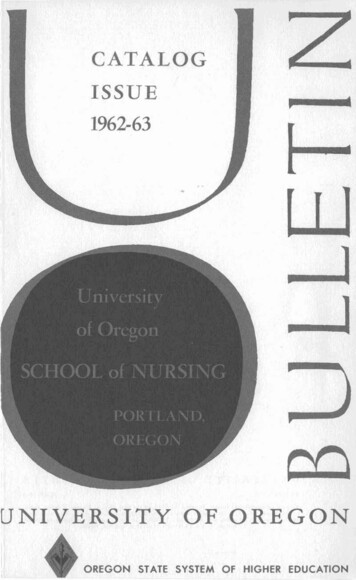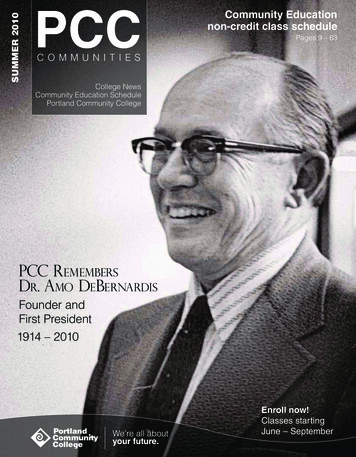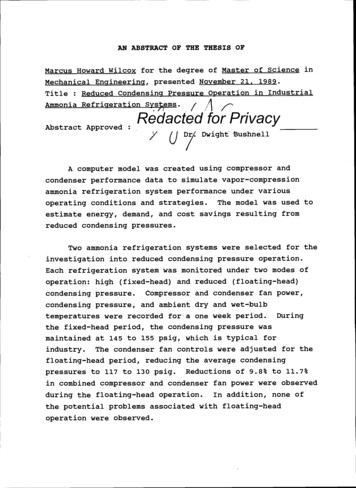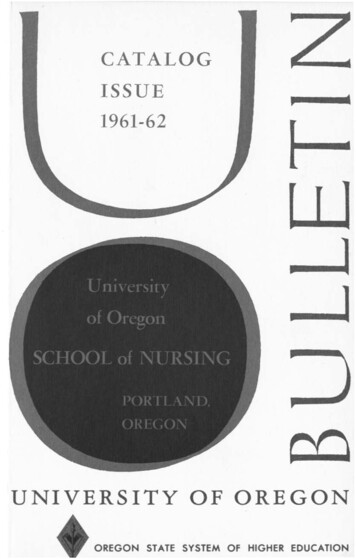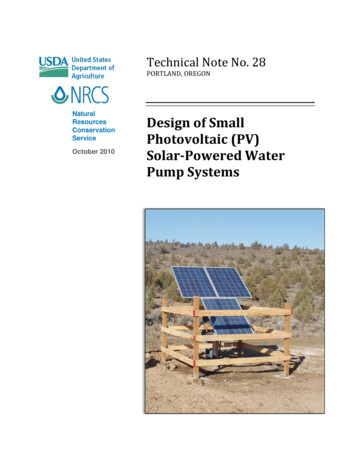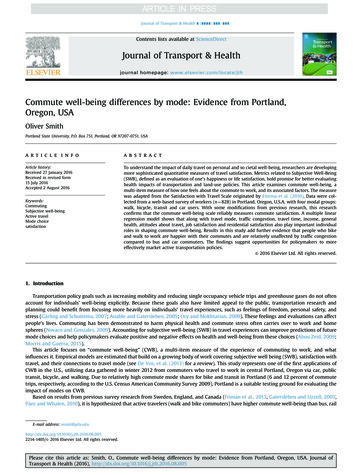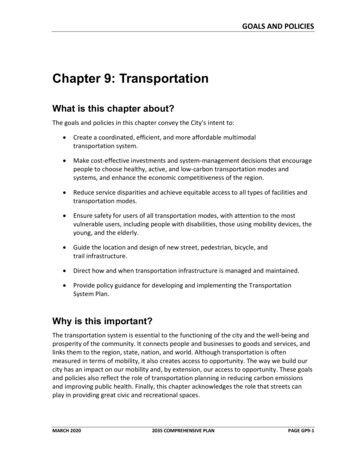
Transcription
GOALS AND POLICIESChapter 9: TransportationWhat is this chapter about?The goals and policies in this chapter convey the City’s intent to: Create a coordinated, efficient, and more affordable multimodaltransportation system. Make cost-effective investments and system-management decisions that encouragepeople to choose healthy, active, and low-carbon transportation modes andsystems, and enhance the economic competitiveness of the region. Reduce service disparities and achieve equitable access to all types of facilities andtransportation modes. Ensure safety for users of all transportation modes, with attention to the mostvulnerable users, including people with disabilities, those using mobility devices, theyoung, and the elderly. Guide the location and design of new street, pedestrian, bicycle, andtrail infrastructure. Direct how and when transportation infrastructure is managed and maintained. Provide policy guidance for developing and implementing the TransportationSystem Plan.Why is this important?The transportation system is essential to the functioning of the city and the well-being andprosperity of the community. It connects people and businesses to goods and services, andlinks them to the region, state, nation, and world. Although transportation is oftenmeasured in terms of mobility, it also creates access to opportunity. The way we build ourcity has an impact on our mobility and, by extension, our access to opportunity. These goalsand policies also reflect the role of transportation planning in reducing carbon emissionsand improving public health. Finally, this chapter acknowledges the role that streets canplay in providing great civic and recreational spaces.MARCH 20202035 COMPREHENSIVE PLANPAGE GP9-1
TRANSPORTATIONWith its 1980 Comprehensive Plan, the City of Portland became a national leader in theintegration of land use and transportation. The 2035 Comprehensive Plan builds on thattradition and adds new innovations. The goals and policies in this chapter increase the focuson complete multimodal transportation systems. The historical emphasis on automobilemobility increasingly creates a cost burden on households and the community as a whole.For the city to successfully meet its transportation system goals for the future, other moreaffordable choices must be widely available and safe.What is the Transportation System Plan?The Transportation System Plan (TSP) is the 20-year plan to guide transportationinvestments in Portland. The TSP meets state and regional planning requirements andaddresses local transportation needs. It includes: Policies that guide the maintenance, development, and implementation ofPortland’s transportation system. A list of projects necessary to accommodate 20 years of growth in population andemployment, including a financial plan. Master street plans and modal plans. Strategies and regulations for implementation, including street classification maps.Elements of the TSP — the policies, the projects included in the List of SignificantProjects, street classification maps, and street plan maps — are adopted as part of theComprehensive Plan. The TSP itself is adopted concurrently with the ComprehensivePlan but is published under a separate cover. For ease of use and transparency, thecitywide policies from the TSP are also included in this chapter of the ComprehensivePlan.The TSP also provides more detail than the Comprehensive Plan by including additionalsub-policies and area-specific policies, and additional supporting information abouttransportation system conditions. The TSP contains the transportation element of theCity’s Public Facilities Plan. Figure 9-1 — Transportation System Plan: Relationship toOther Policies and Plans illustrates the relationship between the TSP and other policiesand plans.PAGE GP9-22035 COMPREHENSIVE PLANMARCH 2020
GOALS AND POLICIESTable of ContentsGoalsGoal 9.AGoal 9.BGoal 9.CGoal 9.DGoal 9.EGoal 9.FGoal 9.GGoal 9.HGoal 9.ISafetyMultiple goalsGreat placesEnvironmentally sustainableEquitable transportationPositive health outcomesOpportunities for prosperityCost effectivenessAirport FuturesPoliciesDesigning and planningPolicy 9.1Street design classificationsPolicy 9.2Street policy classificationsPolicy 9.3Transportation System PlanPolicy 9.4Use of classificationsPolicy 9.5Mode share goals and Vehicle Miles Travelled (VMT) reductionPolicy 9.6Transportation strategy for people movementPolicy 9.7Moving goods and delivering servicesPolicy 9.8AffordabilityPolicy 9.9Accessible and age-friendly transportation systemPolicy 9.10Geographic policiesLand use, development, and placemakingPolicy 9.11Land use and transportation coordinationPolicy 9.12Growth strategyPolicy 9.13Development and street designStreets as public spacesPolicy 9.14Streets for transportation and public spacesPolicy 9.15Repurposing street spacePolicy 9.16Design with natureModal policiesPolicy 9.17Pedestrian transportationPolicy 9.18Pedestrian networksPolicy 9.19Pedestrian safety and accessibilityPolicy 9.20Bicycle transportationPolicy 9.21Accessible bicycle systemPolicy 9.22Public transportationMARCH 20202035 COMPREHENSIVE PLANPAGE GP9-3
TRANSPORTATIONPolicy 9.23Policy 9.24Policy 9.25Policy 9.26Policy 9.27Policy 9.28Policy 9.29Policy 9.30Policy 9.31Policy 9.32Policy 9.33Policy 9.34Policy 9.35Policy 9.36Policy 9.37Policy 9.38Policy 9.39Policy 9.40Transportation to job centersTransit serviceTransit equityTransit fundingTransit service to centers and corridorsIntercity passenger serviceRegional trafficways and transitwaysMultimodal goods movementEconomic development and industrial landsMultimodal system and hubFreight networkSustainable freight systemFreight rail networkPortland HarborPortland HeliportAutomobile transportationAutomobile efficiencyEmergency responseAirport FuturesPolicy 9.41Portland International AirportPolicy 9.42Airport regulationsPolicy 9.43Airport partnershipsPolicy 9.44Airport investmentsSystem managementPolicy 9.45System managementPolicy 9.46Traffic managementPolicy 9.47ConnectivityPolicy 9.48TechnologyPolicy 9.49Performance measuresPolicy 9.50Regional congestion managementPolicy 9.51Multimodal Mixed-Use AreaTransportation Demand ManagementPolicy 9.52OutreachPolicy 9.53New developmentPolicy 9.54Projects and programsPAGE GP9-42035 COMPREHENSIVE PLANMARCH 2020
GOALS AND POLICIESParking managementPolicy 9.55Parking managementPolicy 9.56Curb ZonePolicy 9.57On-street parkingPolicy 9.58Off-street parkingPolicy 9.59Share space and resourcesPolicy 9.60Cost and pricePolicy 9.61Bicycle parkingFinance, programs, and coordinationPolicy 9.62CoordinationPolicy 9.63New development impactsPolicy 9.64Education and encouragementPolicy 9.65TelecommutingPolicy 9.66Project and program selection criteriaPolicy 9.67FundingNew MobilityPolicy 9.68New mobility priorities and outcomesPolicy 9.69New mobility toolsList of Tables9-1. City Level of Service9-2. Oregon Metro Interim Deficiency Thresholds and Operating StandardsList of Figures9-1. Transportation System Plan: Relationship to Other Policies and Plans9-2. Central City Multimodal Transportation Area (MMA)9-3. Portland International AirportMARCH 20202035 COMPREHENSIVE PLANPAGE GP9-5
GoalsGOAL 9.A: SafetyThe City achieves the standard of zero traffic-related fatalities and serious injuries.Transportation safety impacts the livability of a city and the comfort and security of thoseusing City streets. Comprehensive efforts to improve transportation safety through equity,engineering, education, enforcement and evaluation will be used to eliminate traffic-relatedfatalities and serious injuries from Portland’s transportation system.Goal 9.B: Multiple goalsPortland’s transportation system is funded and maintained to achieve multiple goals andmeasurable outcomes for people and the environment. The transportation system is safe,complete, interconnected, multimodal, and fulfills daily needs for people and businesses.GOAL 9.C: Great placesPortland’s transportation system enhances quality of life for all Portlanders, reinforcesexisting neighborhoods and great places, and helps make new great places in town centers,neighborhood centers and corridors, and civic corridors.GOAL 9.D: Environmentally sustainableThe transportation system increasingly uses active transportation, renewable energy, orelectricity from renewable sources, achieves adopted carbon reduction targets, and reducesair pollution, water pollution, noise, and Portlanders’ reliance on private vehicles.GOAL 9.E: Equitable transportationThe transportation system provides all Portlanders options to move about the city and meettheir daily needs by using a variety of safe, efficient, convenient, and affordable modes oftransportation. Transportation investments are responsive to the distinct needs of eachcommunity.GOAL 9.F: Positive health outcomesThe transportation system promotes positive health outcomes and minimizes negativeimpacts for all Portlanders by supporting active transportation, physical activity, andcommunity and individual health.GOAL 9.G: Opportunities for prosperityThe transportation system supports a strong and diverse economy, enhances thecompetitiveness of the city and region, and maintains Portland’s role as a West Coast tradegateway and freight hub by providing efficient and reliable goods movement, multimodalaccess to employment areas and educational institutions, as well as enhanced freight accessto industrial areas and intermodal freight facilities. The transportation system helps peopleand businesses reduce spending and keep money in the local economy by providingaffordable alternatives to driving.PAGE GP9-62035 COMPREHENSIVE PLANMARCH 2020
GOALS AND POLICIESGOAL 9.H: Cost effectivenessThe City analyzes and prioritizes capital and operating investments to cost effectivelyachieve the above goals while responsibly managing and protecting our past investments inexisting assets.GOAL 9.I: Airport FuturesPromote a sustainable airport (Portland International Airport [PDX]) by meeting the region’sair transportation needs without compromising livability and quality of life for futuregenerations.PoliciesDesign and planningThe City of Portland’s transportation system is a key public facility. The following policiesdescribe what the transportation system is, what it does, and what factors to consider inhow the overall system is used. Policies 8.1-8.60 in Chapter 8: Public Facilities and Servicesalso apply to the need for quality facilities and services, multiple benefits, reliability, andcreating a multi-purpose and safe right-of-way.Policy 9.1Street design classifications. Maintain and implement street designclassifications consistent with land use plans, environmental context, urbandesign pattern areas, and the Neighborhood Corridor and Civic CorridorUrban Design Framework designations.Policy 9.2Street policy classifications. Maintain and implement street policyclassifications for pedestrian, bicycle, transit, freight, emergency vehicle, andautomotive movement, while considering access for all modes, connectivity,adjacent planned land uses, and state and regional requirements.9.2.a. Designate district classifications that emphasize freight mobility andaccess in industrial and employment areas serving high levels of truck trafficand to accommodate the needs of intermodal freight movement.9.2.b. Designate district classifications that give priority to pedestrian accessin areas where high levels of pedestrian activity exist or are planned,including the Central City, Gateway regional center, town centers,neighborhood centers, and transit station areas.9.2.c. Designate district classifications that give priority to bicycle access andmobility in areas where high levels of bicycle activity exist or are planned,including Downtown, the River District, Lloyd District, Gateway RegionalCenter, town centers, neighborhood centers, and transit station areas.MARCH 20202035 COMPREHENSIVE PLANPAGE GP9-7
Policy 9.3Transportation System Plan. Maintain and implement the TransportationSystem Plan (TSP) as the decision-making tool for transportation-relatedprojects, policies, programs, and street design.Policy 9.4Use of classifications. Plan, develop, implement, and manage thetransportation system in accordance with street design and policyclassifications outlined in the Transportation System Plan.9.4.a Classification descriptions are used to describe how streets shouldfunction for each mode of travel, not necessarily how they are functioning atpresent.Policy 9.5Policy 9.6Mode share goals and Vehicle Miles Travelled (VMT) reduction. Increasethe share of trips made using active and low-carbon transportation modes.Reduce VMT to achieve targets set in the most current Climate Action Planand Transportation System Plan, and meet or exceed Metro’s mode shareand VMT targets.Transportation strategy for people movement. Implement a prioritization ofmodes for people movement by making transportation system decisionsaccording to the following ordered list:1. Walking2. Bicycling3. Transit4. Fleets of electric, fully automated, multiple passenger vehicles5. Other shared vehicles6. Low or no occupancy vehicles, fossil-fueled non-transit vehiclesWhen implementing this prioritization, ensure that: The needs and safety of each group of users are considered, and changesdo not make existing conditions worse for the most vulnerable usershigher on the ordered list. All users’ needs are balanced with the intent of optimizing the right ofway for multiple modes on the same street. When necessary to ensure safety, accommodate some users on parallelstreets as part of a multi-street corridor. Land use and system plans, network functionality for all modes, otherstreet functions, and complete street policies, are maintained. Policy-based rationale is provided if modes lower in the ordered list areprioritized.Policy 9.7PAGE GP9-8Specific modal policies are found below in policies 9.17 to 9.40.Moving goods and delivering services. In tandem with people movement,maintain efficient and reliable movement of goods and services as a critical2035 COMPREHENSIVE PLANMARCH 2020
GOALS AND POLICIEStransportation system function. Prioritize freight system reliabilityimprovements over single-occupancy vehicle mobility where there aresolutions that distinctly address those different needs. Multimodal freightpolicies are found below in policies 9.33 to 9.35.Policy 9.8Affordability. Improve and maintain the transportation system to increaseaccess to convenient and affordable transportation options for allPortlanders, especially those who have traditionally been under-served orunder-represented or have historically borne unequal burdens.Policy 9.9Accessible and age-friendly transportation system. Ensure thattransportation facilities are accessible to people of all ages and abilities, andthat all improvements to the transportation system (traffic, transit, bicycle,and pedestrian) in the public right-of-way comply with the Americans withDisabilities Act of 1990. Improve and adapt the transportation system tobetter meet the needs of the most vulnerable users, including the young,older adults, and people with different abilities.Policy 9.10Geographic policies. Adopt geographically-specific policies in theTransportation System Plan to ensure that transportation infrastructurereflects the unique topography, historic character, natural features, systemgaps, economic needs, demographics, and land uses of each area. Use thePattern Areas identified in Chapter 3: Urban Form as the basis for areapolicies.9.10.a Refer to adopted area plans for additional applicable geographicobjectives related to transportation. Land use, development, andplacemakingLand use patterns and connections among different land uses are key elements defining theform and character of places. In tandem with Chapter 3: Urban Form and Chapter 4: Designand Development, the policies in this section give direction for designing and building atransportation system that supports, complements, and meets the needs of differentplaces. These policies acknowledge development adjacent to transportation as a criticalcomponent in shaping the future of Portland’s public spaces and places.Policy 9.11MARCH 2020Land use and transportation coordination. Implement the ComprehensivePlan Map and the Urban Design Framework though coordinated long-rangetransportation and land use planning. Ensure that street policy and designclassifications and land uses complement one another.2035 COMPREHENSIVE PLANPAGE GP9-9
Policy 9.12Growth strategy. Use street design and policy classifications to support Goals3A-3G in Chapter 3: Urban Form. Consider the different design contexts andtransportation functions in Town Centers, Neighborhood Centers,Neighborhood Corridors, Employment Areas, Freight Corridors, CivicCorridors, Transit Station Areas, and Greenways.Policy 9.13Development and street design. Evaluate adjacent land uses to help informstreet classifications in framing, shaping, and activating the public space ofstreets. Guide development and land use to create the kinds of places andstreet environments intended for different types of streets.Streets as public spacesStreets, including sidewalks and planting strips, provide critical transportation and utilityfunctions. In Portland, streets are the most abundant type of public space, occupying nearly20 percent of land area in the city. The following policies support community desire toexpand the use of streets beyond their transportation functions. See Chapter 8: PublicFacilities and Services and Chapter 4: Design and Development for further use andstreetscape policies.Policy 9.14Streets for transportation and public spaces. Integrate both placemakingand transportation functions when designing and managing streets byencouraging design, development, and operation of streets to enhanceopportunities for them to serve as places for community interaction,environmental function, open space, tree canopy, recreation, and othercommunity purposes.Policy 9.15Repurposing street space. Encourage repurposing street segments that arenot critical for transportation connectivity to other community purposes.Policy 9.16Design with nature. Promote street and trail alignments and designs thatrespond to topography and natural features, when feasible, and protectstreams, wildlife habitat, and native trees.PAGE GP9-102035 COMPREHENSIVE PLANMARCH 2020
GOALS AND POLICIESModal policiesPortland is committed to providing a multimodal transportation system that offersaffordable and convenient travel options within the city, region, and outside the Metroarea. Because trips are made for different reasons, they vary in length and type of vehicle(mode) needed to make them. Different modes create different kinds of impacts — onneighborhood livability and carbon emissions, for example. These policies recognize thatsome modes are more appropriate than others for different types of trips.Policy 9.17Pedestrian transportation. Encourage walking as the most attractive modeof transportation for most short trips, within neighborhoods and to centers,corridors, and major destinations, and as a means for accessing transit.Policy 9.18Pedestrian networks. Create more complete networks of pedestrianfacilities, and improve the quality of the pedestrian environment.Policy 9.19Pedestrian safety and accessibility. Improve pedestrian safety, accessibility,and convenience for people of all ages and abilities.Policy 9.20Bicycle transportation. Create conditions that make bicycling more attractivethan driving for most trips of approximately three miles or less.Policy 9.21Accessible bicycle system. Create a bicycle transportation system that issafe, comfortable, and accessible to people of all ages and abilities.Policy 9.22Public transportation. Coordinate with public transit agencies to createconditions that make transit the preferred mode of travel for trips that arelonger than 3 miles or shorter trips not made by walking or bicycling.9.22.a Consider and incorporate transit priority treatments, such as those inThe Enhanced Transit Corridors Plan, to improve transit speed and reliabilityduring the planning and design phase of capital projects and permittedprojects along streets served by transit lines.Policy 9.23Transportation to job centers. Promote and enhance transit to be moreconvenient and economical than the automobile for people travelling morethan three miles to and from the Central City and Gateway. Enhance regionalaccess to the Central City and access from Portland to other regionaljob centers.Policy 9.24Transit service. In partnership with TriMet, develop a public transportationsystem that conveniently, safely, comfortably, and equitably serves residentsand workers 24 hours a day, 7 days a week.MARCH 20202035 COMPREHENSIVE PLANPAGE GP9-11
Policy 9.25Transit equity. In partnership with TriMet, maintain and expand high-qualityfrequent transit service to all Town Centers, Civic Corridors, NeighborhoodCenters, Neighborhood Corridors, and other major concentrations ofemployment, and improve service to areas with high concentrations ofpoverty and historically under-served and under-represented communities.9.25.a Support a public transit system and regional transportation thataddress the transportation needs of historically marginalized communitiesand provide increased mobility options and access.Policy 9.26Transit funding. Consider funding strategies and partnership opportunitiesthat improve access to and equity in transit service, such as raising metrowide funding to improve service and decrease user fees/fares.Policy 9.27Transit service to centers and corridors. Use transit investments as a meansto shape the city’s growth and increase transit use. In partnership withTriMet and Metro, maintain, expand, and enhance Portland Streetcar,frequent service bus, and high-capacity transit, to better serve centers andcorridors with the highest intensity of potential employment and householdgrowth.9.27.a Locate major park-and-ride lots only where transit ridership isincreased significantly, vehicle miles traveled are reduced, transit-supportivedevelopment is not hampered, bus service is not available or is inadequate,and the surrounding area is not negatively impacted.Policy 9.28Intercity passenger service. Coordinate planning and project development toexpand intercity passenger transportation services in the Willamette Valley,and from Portland to California, Seattle, and Vancouver, BC.Policy 9.29Regional trafficways and transitways. Maintain capacity of regionaltransitways and existing regional trafficways to accommodatethrough-traffic.Policy 9.30Multimodal goods movement. Develop, maintain, and enhance amultimodal freight transportation system for the safe, reliable, sustainable,and efficient movement of goods within and through the city.Policy 9.31Economic development and industrial lands. Ensure that the transportationsystem supports traded sector economic development plans and fullutilization of prime industrial land, including brownfield redevelopment.Policy 9.32Multimodal system and hub. Maintain Portland’s role as a multimodal hubfor global and regional movement of goods. Enhance Portland’s network ofmultimodal freight corridors.PAGE GP9-122035 COMPREHENSIVE PLANMARCH 2020
GOALS AND POLICIESPolicy 9.33Freight network. Develop, manage, and maintain a safe, efficient, andreliable freight street network to provide freight access to and fromintermodal freight facilities, industrial and commercial districts, and theregional transportation system. Invest to accommodate forecasted growth ofinterregional freight volumes and provide access to truck, marine, rail, andair transportation systems. Ensure designated routes and facilities areadequate for over-dimensional trucks and emergency equipment.Policy 9.34Sustainable freight system. Support the efficient delivery of goods andservices to businesses and neighborhoods, while also reducingenvironmental and neighborhood impacts. Encourage the use of energyefficient and clean delivery vehicles, and manage on- and off-street loadingspaces to ensure adequate access for deliveries to businesses, whilemaintaining access to homes and businesses.Policy 9.35Freight rail network. Coordinate with stakeholders and regional partners tosupport continued reinvestment in, and modernization of, the freightrail network.Policy 9.36Portland Harbor. Coordinate with the Port of Portland, private stakeholders,and regional partners to improve and maintain access to marine terminalsand related river-dependent uses in Portland Harbor.9.36.a. Support continued reinvestment in, and modernization of, marineterminals in Portland Harbor.9.36.b. Facilitate continued maintenance of the shipping channels in PortlandHarbor and the Columbia River.9.36.c. Support shifting more long-distance, high-volume movement of goodsto river and oceangoing ships and rail.See Policy 3.71 for the river transportation policy.Policy 9.37Portland Heliport. Maintain Portland’s Heliport functionality in theCentral City.Policy 9.38Automobile transportation. Maintain acceptable levels of mobility andaccess for private automobiles while reducing overall vehicle miles traveled(VMT) and negative impacts of private automobiles on the environment andhuman health.Policy 9.39Automobile efficiency. Coordinate land use and transportation plans andprograms with other public and private stakeholders to encourage vehicletechnology innovation, shifts toward electric and other cleaner, moreenergy-efficient vehicles and fuels, integration of smart vehicle technologyMARCH 20202035 COMPREHENSIVE PLANPAGE GP9-13
with intelligent transportation systems, and greater use of options such ascar-share, carpool, and taxi.Policy 9.40Emergency response. Maintain a network of accessible emergencyresponse streets to facilitate safe and expedient emergency response andevacuation. Ensure that police, fire, ambulance, and other emergencyproviders can reach their destinations in a timely fashion, without negativelyimpacting traffic calming and other measures intended to reduce crashes andimprove safety.Airport FuturesThe Port of Portland manages the Portland International Airport (PDX) as a regional,national, and international air transportation hub. The Port partnered with the City ofPortland and Multnomah, Washington, and Clackamas Counties to prepare the AirportFutures Plan (2010) and guide airport development to 2035. Policy direction set in thisproject include Goal 9.I and the following policies. Additional airport-related policies arefound in Chapter 4: Design and Development and Chapter 7: Environment andWatershed Health.Policy 9.41Portland International Airport. Maintain the Portland International Airportas an important regional, national, and international transportation hubserving the bi-state economy.Policy 9.42Airport regulations. Implement the Airport Futures Plan through theimplementation of the Portland International Airport Plan District.9.42.a. Prohibit the development of a potential third parallel runway at PDXunless need for its construction is established through a transparent,thorough, and regional planning process.9.42.b. Support implementation of the Aircraft Landing Zone to provide saferoperating conditions for aircraft in the vicinity of Portland InternationalAirport by limiting the height of structures, vegetation, andconstruction equipment.9.42.c. Support the Port of Portland’s Wildlife Hazard Management Plan byimplementing airport-specific landscaping requirements in the PortlandInternational Airport Plan District to reduce conflicts between wildlifeand aircraft.PAGE GP9-142035 COMPREHENSIVE PLANMARCH 2020
GOALS AND POLICIESPolicy 9.43Airport partnerships. Partner with the Port of Portland and the regionalcommunity to address the critical interconnection between economicdevelopment, environmental stewardship, and social responsibility. Supportan ongoing public advisory committee for PDX to:9.43.a. Support meaningful and collaborative public dialogue andengagement on airport related planning and development.9.43.b. Provide an opportunity for the community to inform the decisionmaking related to the airport of the Port, the City of Portland, and otherjurisdictions/organizations in the region.9.43.c. Raise public knowledge about PDX and impacted communities.Policy 9.44Airport investments. Ensure that new development and redevelopment ofairport facilities supports the City’s and the Port’s sustainability goals andpolicies, and is in accordance with Figure 9-3 — Portland InternationalAirport. Allow the Port flexibility in configuring airport facilities to preservefuture development options, minimize environmental impacts, use landresources efficiently, maximize operational efficiency, ensure developmentcan be effectively phased, and address Federal Aviation Administration’sairport design criteria.System managementPortland’s transportation system is an integrated network of roads, rails, trails, sidewalks,bicycle paths, and other facilities within and through the city. These modal networksintersect and are often located within the same right-of-way. The policies below providedirection to manage the system in ways that: Allow different modes to interact safely.Maximize the capacity of the existing network.Identify where additional capacity might be needed.Also see Policies 8.37 through 8.49 in Chapter 8: Public Facilities and Services.Policy 9.45System management. Give preference to transportation improvements thatuse existing roadway capacity efficiently and that improve the safety of thesystem for all users.9.45.a Support regional equity measures for transportation systemevaluation.MARCH 20202035 COMPREHENSIVE PLANPAGE GP9-15
Policy 9.46Traffic management. Evaluate and encourage traffic speed and volume to beconsistent with street classifications and desired land uses to improve safety,preserve and
Policy 9.5 Mode share goals and Vehicle Miles Travelled (VMT) reduction . Policy 9.6 Transportation strategy for people movement . Policy 9.7 Moving goods and delivering services . Policy 9.8 Affordability . Policy 9.9 Accessible and age-friendly transportation system . Policy 9.10 Geographic policies


